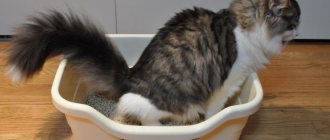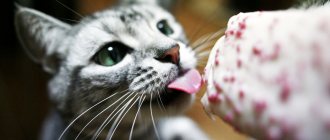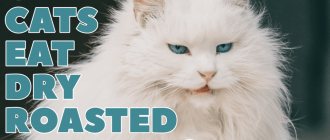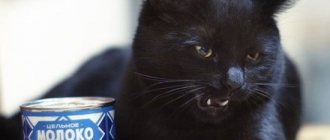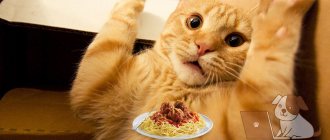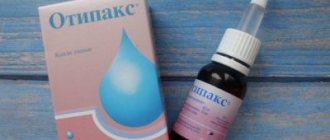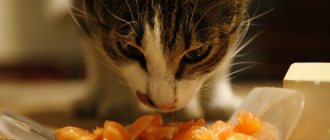Physiology of taste in cats
When a cat receives a piece of chocolate or caramel or ice cream from the owner’s hands, it, at first glance, eats the sweets with pleasure. In fact, she is attracted to the fats and dairy products found in treats. But the taste itself remains uncertain for the pet; it does not feel it and does not receive the pleasure characteristic of a person.
The reason for this phenomenon is explained by the absence of the Tas 1r2 gene in cats. It is its content in the blood of mammals that is responsible for the craving for sweets.
For cats, animal proteins, found in large quantities in meat, are a treat, and sugar and all its derivatives are just a by-product found in ice cream and chocolate.
A cat can recognize any protein with amazing ease. It is noteworthy that wild feline predators are able to determine by smell whether the prey they hunt is alive, injured, or already dead.
And since cats are not able to recognize sugar, they do not feel and do not control the amount of its consumption. Therefore, they can easily exceed the safe dose, which is actually very low. There is only one way out - do not give sweets to cats at all.
If in tiny quantities sweets are simply useless for cats, then at the slightest excess of the norm it becomes very dangerous.
Reasons why cats desire chocolate
Can dogs have sweets, candy and sugar?
It is very unusual to see a situation where a cat eats sweets. If this happens, it may be due to several reasons:
- nutritional deficiency of substances;
- health problems;
- genetic predisposition;
- environmental factors;
- compulsive disorder.
Some cats prefer sweets because of the smell.
Healthy vitamins in chocolate
There are no beneficial vitamins for pets in chocolate. The only need may arise when the animal is experiencing a calorie deficit. This is where chocolate comes to the rescue. Instinctively, the pet feels that it needs additional calories (for example, when it is active), and eats sweets.
Before giving chocolate to your cat, you should consider certain rules:
- calculate the safe amount of chocolate;
- a dangerous dose is considered to be 20 mg of theobromine per 0.5 kg of weight;
- Give chocolate rarely;
- At the same time, you should drink water.
Important! If your pet loves chocolate, you should give him white as it is the safest option for his health.
Nice smell
Cats love delicious smells. Everyone has their own preferences in smell. Some of them love the smell of chocolate, which can make them want to eat it.
If your cat starts asking for sweets, such as ice cream, then most likely she is attracted to the smell of milk proteins or certain synthetic additives.
The pleasant smell of sweetness attracts the animal
Bad Education
If a cat has been accustomed to eating sweets since childhood, then he will continue to do this into adulthood, which is extremely harmful to health.
In such a situation, you should consult a veterinarian to help solve the problem of your pet’s excessive needs.
Possible explanations for the desire to eat sweets:
- the animal is attracted not by taste, but by smell;
- the cat likes the consistency of the product;
- the pet loves to eat from the owner’s hands;
- the presence of vitamin deficiency (lack of certain substances);
- unbalanced diet, irregular eating schedule.
What is the harm of sweets for a cat?
The most dangerous sweet for cats is chocolate. The content of the alkaloid theobromine in cocoa beans is very high. When it enters the cat's body in small doses, a jump in blood pressure occurs, the animal develops tachycardia, and abnormal agitation appears.
If a cat consumes chocolate excessively, poisoning quickly occurs, which most often ends in death. Since the animal’s kidneys and liver accumulate this alkaloid, but are not capable of decomposing it and removing it from the body. But any product containing sugar is no less harmful to the cat. The carbohydrate content in it is very high; the cat has no need for such concentrations in the blood.
The carbohydrate that an animal receives from dry food or natural healthy food is quite sufficient for the normal functioning of the body. And the excess is deposited in the form of fat reserves - subcutaneous and, what is much worse, on the walls of internal organs, which leads to obesity of the liver, kidneys, and other body systems.
It is especially dangerous to give sweets to young animals, elderly pets, pregnant and lactating females, and animals with chronic diseases.
In old animals, sweets will sharply increase the fragility of blood vessels. And eating chocolate by pregnant cats can lead to miscarriages, the development of fetal pathologies and the birth of stillborn kittens.
Sweets are not fun for your pet.
Sweets do not improve a cat's mood, even if she willingly eats them. This happens because our four-legged friends do not have receptors on their tongues that are responsible for distinguishing taste. Therefore, sweets are not such for them. A cat can eat various desserts only because they contain proteins that are necessary for the cat's body. But on the contrary, they do not need excess carbohydrates at all and can even harm their health.
Sweets and cat diseases
The first thing that can happen to a pet when eating sweets is a decrease in immunity and the development of many serious diseases.
Immune defense disorders
Even a small piece of chocolate can cause severe poisoning in a cat. And if everything seems to have gone well, the consequences may be distant.
The immune system was damaged in any case. And against the background of this disorder, allergic reactions may occur, diseases of the oral cavity may appear, numerous redness, ulcers and sores form on the gums, itching of the skin, hair loss begins and the development of alopenia.
Chocolate, sweets, and cakes can also cause a deterioration in a cat’s vision, including blindness, as well as cause diarrhea and vomiting, and increased salivation.
Decreased immunity undermines the cat's body's defenses. The animal becomes susceptible to colds and viral diseases, otitis media and conjunctivitis, fungal infections of any organs.
The digestive system also suffers, the animal develops a false feeling of fullness, and the digestibility of animal protein deteriorates. Oxygen saturation of tissues decreases, and the aging process of the entire organism as a whole accelerates.
Urolithiasis disease
Cats' kidneys are the first to suffer when they eat sweets. Due to intensive work (after all, this is a purification system that unsuccessfully tries to remove harmful products from the body), they significantly increase in size.
The animal's organs are subject to wear and tear, and the acid-base balance is disturbed. And sweets can lead to this just as much as salty foods.
Depending on the type of sweets, either excessive oxidation or alkalization of the body occurs, which in any case leads to the development of kidney failure. Urolithiasis, when eating sweets in large quantities, occurs even in cats that do not have a predisposition to it.
Diabetes
A cat's body is not designed to process large amounts of glucose. Insulin begins to be produced in concentrations that greatly exceed the permissible norm in the blood.
The cat quickly loses sensitivity to this substance, the level of glucose in both the blood and the animal’s urine always remains at high levels, diabetes mellitus quickly develops and the pet becomes a hostage to the “sugar” diet.
Excess carbohydrates
A person often eats a piece of chocolate when he needs to quickly increase energy levels, relieve fatigue, improve the ability to think and make decisions instantly, during heavy mental or physical work. And after even a small dose of chocolate, you feel a surge of strength and acceleration of thought.
By offering the same piece of treat to a pet, the owner causes him great harm. Especially for a cat in a small apartment, where she does not have the opportunity to move enough. All excess carbohydrates, even if they do not lead to serious illnesses, will certainly be stored in the form of excess fat.
Nature provides for the consumption of large quantities of proteins by predators, which is the key to their health and longevity. Carbohydrates are needed in minimal quantities; exceeding the required level means dooming your pet to illness and early death.
Chocolate is a real poison for your pet!
Under no circumstances should you give chocolate to your four-legged friend. After all, this treat contains theobromine, which is poisonous to cats. Any, even the smallest, piece raises her blood pressure and increases her heart rate. Chocolate can cause seizures in animals. The pet may lose consciousness and even die if the dose is lethal.
You should also be careful about caffeine-containing products. Excess caffeine will disrupt your cat's sleep and may lead to digestive problems. Dairy products, which contain sugar, as well as dried fruits and sweet nuts, which contain too many carbohydrates, should be excluded from the cat's diet.
When does a cat need sugar?
But still, in some cases, the pet needs additional sugar. They are very rare and are the consequences of serious illness or recovery in the postoperative period. And only when the level of glucose in the blood is much lower than the norm acceptable for the cat’s body.
In no case does the owner of the animal have the right to make such an appointment if he does not want to cause irreparable harm to him. Only a veterinarian, after a thorough analysis, can decide on a special “sweet” diet.
But even in this case, cats are prohibited from chocolate, cakes, pastry buns, cookies and sweet yoghurts, and especially carbonated drinks. Surprisingly, many pets are very fond of Coca-Cola and Fanta, sweet tea.
In these cases, the veterinarian prescribes a strictly dosed intake of glucose solution or sweetened water. If a sick animal refuses to drink the medicine, it is forcibly administered into the mouth using a syringe without a needle or as an intravenous drip in a hospital setting. Sometimes a specialist prescribes subcutaneous administration of drugs with a high content of monosaccharides at home.
Therapy is carried out under strict control with regular testing. As soon as the sugar level in the cat’s blood and urine returns to normal, glucose intake must be stopped.
In what form is sugar allowed?
Sweets should not be given to cats, but this does not mean that sugar is prohibited in absolutely any form. There are many natural gifts that contain natural sugar - fructose, glucose. Such components will not harm the cat's health. Often, pets living in the private sector themselves beg their owners for a fresh portion of sweet berries or vegetables in the garden beds. Dried and ripe fruits are a real storehouse of healthy sugars. Some of the treats you can give to cats include:
Apples. Ripe apples contain not only useful vitamins and minerals, but also such a necessary component as fiber. Its fibers have a positive effect on the functioning of the gastrointestinal tract, and also cleanse the animal’s teeth of plaque.
Pears. These fruits also contain a lot of fiber, vitamins and minerals.
Plums and apricots. Everyone knows the taste of these fruits. But they can only be given to cats in small quantities.
Melons
Such products should be given to pets with caution. So, watermelon usually puts a lot of strain on the kidneys, and melon is difficult to digest, so you shouldn’t overdo it with such treats, or even not give it to your pet at all.
Dates, dried apricots, figs
These fruits can be given to mustachioed friends on rare occasions. Fruits can be either dried or dried. Some cats love these treats.
Blackberries, blueberries, raspberries. These fruits can also be included in the cat's menu. True, this can be done if the animal is not allergic. Otherwise, the animal may suffer from an allergic reaction.
Another well-known natural product containing natural sugar is honey. However, it must be handled with the utmost care. It can be given to cats, but literally a drop at a time, added to already prepared food. This way, you can immediately see if your pet is allergic to this beekeeping product.
What sweets can a cat eat?
During the summer heat, many owners, showing false concern for their pet, give it ice cream. It seems that both the dairy product itself and cooling the body should only bring benefits. But in fact they do a lot of harm to the cat.
Ice cream for a cat, if necessary, can be easily made independently by freezing unsweetened natural yogurt, fermented baked milk or a mixture of cottage cheese and kefir. Almost all pets love these impromptu treats.
You can give cats a little corn and bell pepper, they have a sweetish taste. The sugar content in them is minimal, and there is a lot of healthy fiber. Almost all cats like these products.
It’s only better if the vegetables are boiled and the peppers are peeled. Under no circumstances should these products be consumed in canned form.
1111
How sugar can harm you
All sugar-containing treats pose a serious danger to cats of all ages, but pregnant and lactating females, small kittens and older cats are most affected. With prolonged consumption of foods containing sugar, even the healthiest animals can develop diseases.
Gastrointestinal disorders
An excess of sweets can cause stool disorders (diarrhea or constipation), gastritis, various types of colitis, and even inflammation of the pancreas. These troubles take a long time to treat, it is difficult, and the animal will have to be on a strict diet.
Development of diabetes
When a cat eats sweets, even in small quantities, the pancreas gets severe overload. If this happens regularly, inflammation develops, leading to organ destruction. Insulin production stops and the cat’s blood sugar rises. By the way, sweeteners (for example, xylitol), added by manufacturers to sweeten foods, also contribute to the development of diabetes. Without maintenance therapy, the life of a diabetic cat is shortened.
Harm to the kidneys and liver
If a cat loves sweets, the risk of urolithiasis increases - the load on the kidneys increases, the acid-base balance is disrupted. KSD causes frequent painful urination and sometimes requires surgical intervention.
Irreversible changes occur in the liver - working tissues are replaced by useless fatty layers. This means that the organ will not be able to remove toxins and waste products as well as before.
Weakening of the immune system
When sugar enters the intestines, the number of protective cells decreases many times, which has a bad effect on the animal’s immunity. The cat becomes unstable to bacterial and viral attacks, even if it is vaccinated. In severe cases, disruptions occur in the endocrine system.
Fat deposits
Pets do not use as much energy as outdoor pets. As a result, fat deposits accumulate, both subcutaneous and internal. The latter envelop the organs, as a result their performance decreases.
Obesity leads to a lot of health problems: from diseases of internal organs to arthritis and arthrosis.
Diseases of the teeth and oral cavity
The cause of microcracks in tooth enamel is sweetened food. It also provokes the appearance of caries, tartar, bleeding gums, and tooth loss. The main problem is that sugars wash out calcium in the body, which has a bad effect on the condition of teeth and bones. And treating dental problems in animals is complex, difficult and very expensive.
Allergy
The liver and pancreas process and utilize carbohydrates in the body. If an animal consumes a lot of harmful treats, these organs do not have time to process sugar and, as a result, a lot of glycogen accumulates in reserve. At one point, the body begins to react to excess carbohydrates as an allergen. So if your cat starts itching or has discharge from her eyes, immediately stop giving her harmful treats.
How to pamper your furry friend?
Delicious treats help strengthen the bond between owner and pet. Fortunately, there are many options for pampering your pet. Forget about chocolate cake, donuts, cotton candy, waffles and marshmallows, which are completely unsuitable for cats. Better treat her with a small portion of a delicious cat delicacy. Below are the options.
Small pieces of meat. Small cubes of chicken or turkey (length of one side 1.5-2.5 cm) without foreign impurities (spices, salt, sauce, etc.) delight cats, making them purr with pleasure. With such a treat, your pet can become a full-fledged participant in the festive event, having his own festive dinner.
Special treats from the pet store.
Your cat's favorite food. Pets have their own habits, including eating. They may have a preference for one particular treat, and even if they get it every day, they are reluctant to change their preferences.
Food for every day. A win-win option is to pamper your pet with a small additional portion of his daily diet.
How much joy and pleasure a person brings to communication with his cute four-legged friend. Of course, the owner wants to do something nice for him. A great way is to treat them with a small treat that will not only be tasty, but also healthy.
Use a delicious and safe snack to make your bond with your furry family member even stronger.
Based on materials from bondvet.com

